Portfolio: Skin Dive: Photographic Water Portraiture
- CV
- Night Mothers
- Night Mothers4
- HCE, Chrysecolla
- HCE58, Chrysecolla
- Winter Term Toes
- K, from the Adapted Aquatics Series Rockin’ the Spectrum, Chapel Hill,
- J, from the Adapted Aquatics Series Rockin’ the Spectrum, Chapel Hill, NC
- Mirinda, in a Pool of Her Own
- Richard
These water portraits, conceived through the synthesis of light, imagination, and technology, derive from multiple sites ranging from Beijing, China, to the Yale University Pool, to private homes in Sarasota, Florida, to therapeutic aquatic centers along the East Coast of the United States.
The images are representational, in that they document or, perhaps better, bear witness to the actual people, places, and events I bring into the lens, without digital manipulation. But this is obviously neither literal realism nor documentary photography in the conventional sense. The lines, markings, shapes, and colors created by the body’s immersion in water form a distinctive aesthetic whole. The parts of the body, while recognizable at least with a close look, also become a burst of multilayered refractions. The refractions were there, in the eye’s reality, but they project an aura of fantasy, mystery, even a kind of chaos, which can at first be disorienting. I want to make the viewer aware of patterns of shape and color beneath the apparent chaos, patterns that will evoke the human experience of water in a variety of settings.
On a technical level, I was drawn to the abstract qualities of many of the images and began cultivating that in some of my portraits, often using silver acrylic panels to further disorient the perception of equilibrium and to enhance reflectivity, light, and pattern. With mirror-like panels placed strategically in the water, human form became bits and pieces of color, more or less apparent or relevant in the final images. Photographically captured, they are single images rather than multiple-image composites, distorted only through the abstractions created by the fluidity of motion and colors.
Water is the source of life, including human life. That may be the primeval reason why we are drawn to it. But we’ve all experienced the fear of water in one way or another. On our own we can’t breathe in it. It can engulf us, drag us down to the terrifying deep beneath a calm surface, drown us. And yet water can also offer freedom and delight. What was fearful becomes supportive, reassuring, allowing one to feel free of the tyranny of gravity. Swimming down into water is like flying; limbs become wings in a skin dive.
Over the past years I have produced a series of water portraits of family, friends, and people in love; colleagues and students; business clients; and strangers. They began with photographs of myself and my young daughter in the pool with my father. At age eighty he was learning to swim to recover from a heart attack and ease the pain of osteoporosis. As we photographed each other in the water, I realized that photos I intended as gifts to him were in his eyes horrible images of his aged body. In the tension-ridden intimacy between father and daughter, I had to ponder how the photographer, however generous her intention, can create and sustain a structure of inequality by exercising the power to objectify her subject.
I have brought this awareness to subsequent projects. Some of my subjects were photographed simply because of their love for swimming, but others have attended swimming classes designed to help with special physical and developmental needs. For children on the autism spectrum the indoor pool and its environment—the water, the splashing, the noise—are a perfect storm of over-stimulation; and yet, despite their neurological cross-wiring, they can learn to swim and gain in confidence as they take pride in that achievement. Elderly people suffering from arthritis find that the water can heal and soothe. People with anguished reactions to life’s challenges use the water to enter a spiritual state of being. Others use the water to celebrate their marriage or to mourn the loss of a loved one.
The work is rooted in my background. I inherited from my parents an ethic of civic service in my own work as an artist, as a public advocate and an educator, working with groups with diverse abilities and challenges. In these images I have tried to integrate that experience and the formal elements of art into a coherent whole, at once personal and public. Form can be an end in itself: all that matters are formal relationships within the image. While I want the viewer to experience the intrinsic beauty of the human body refracted into virtually infinite varieties of shapes in water and light, I’m also using aesthetic form to engage in a kind of advocacy, a widening of our social awareness. I want to evoke, as powerfully as I can, the anxieties and pleasures we all confront in water; the sense of inclusiveness, despite the differences among us, that that experience fosters; the empowerment of people to overcome fears (and the joy of doing that); the trust in others needed to do so.
Each image freezes a moment in the flow of time. The microsecond it captures becomes a memory in a human story that has reached that point and will continue beyond it. Because it retains the ability to embody and sustain memories, photography, I believe, holds a unique position in the arts as a truth-telling medium. Essential to that truth telling are the stories that led up to my clicking the shutter. These emerge from interviews with the participants that helped shape the final images. That is where much of the pleasure of the work lies.
And so in these portraits we find a combination of water, which is life, and light, which is what the camera takes in. One might say that the action of light on water “distorts” the human body. Though that term carries a heavy load of negative connotations, I want these images to give it a positive meaning, to make distortion a vehicle of social and, ultimately, human awareness. The fact is that we’re all equally “distorted” by immersion in water. There is an equality in this kind of shared distortion, a grace it bestows on all, which in turn can produce a sense of shared inclusiveness among people who are or at least seem to be, on terra firma, quite different from each other. These images are meant to convey a paradox about the refractions of light on water and the ways in which they create unfamiliar shapes and bold colors. As strange and unsettling as some of the images may at first seem, making human shapes almost unrecognizable, they help us recognize each other, however different we are, as fully human.


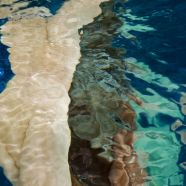





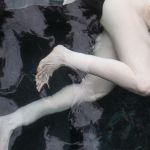
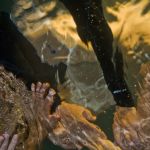

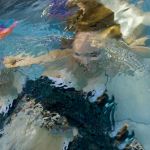
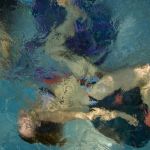
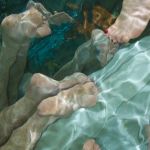
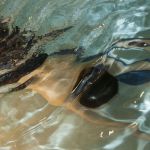
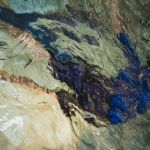
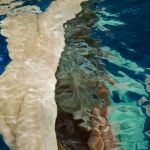
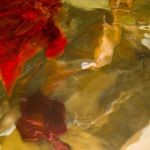
I have so enjoyed your expressions about the effects of water, its deep dive of all things in this human existence that are made somehow clearer, readily illuminated by your picturing bodies of water and people inhabiting those splashed moments.It did my heart good to read and reflect this day 9/11.May peace prevail .Thank you for sharing your artistic perspective and endeavors.You are a wonderful, gifted collaborater .friend.